
Last year, I left my job at ZURB, a renowned product design agency, with nothing lined up.
I had no idea where I was going next. All I knew was it was time for me to spread my wings and begin a new chapter.
At the time, the unknown was frightening. But after much reflection, it was the best decision for my career as a designer. In those months of being unemployed, there were five key things that kept opening new opportunities for me and has helped me become a better designer.
These five items remain on my new year’s resolutions list for the new year as well. I hope they serve you just as well.
1. Teach someone something about design
I ran into my ex-coworker at a Foundation meetup a month after my unemployment.
When I mentioned I was visiting New York for a few days, he pointed me towards a Design First meetup where they were looking for someone to speak about prototyping. Immediately, I jumped at the opportunity because I was getting too comfortable with not having to work. I needed to get outside of my comfort zone by exercising my public speaking and storytelling skills.
The day came, I spoke nervously about product design to over 80 people. I knew I wasn’t ready. I knew I made a fool of myself with shaking knees and trembling voice accompanying me. But I did it, and my design confidence spiked.

Source: Design First
You learn by teaching. You learn by answering questions, by sharing the resources and methods you use, by providing feedback, by sharing your own experiences. By teaching, you will become a better designer.
Teaching comes in all sorts of format. You could:
- Speak at a meetup about your design process (either through meetup or your local UXPA chapter). Aside from the networking benefits, you might also find a mentor.
- Host a lunch-and-learn at work about design skills and processes. Design is a team sport, so the more people you educate, the more UX advocates you create. For example, Citrix’s lunch-and-learns helped convert the company from being engineering-driven to being design-driven.
- Teach a UI or UX course on Skillshare, Youtube, or even Udemy (and maybe even earn residual income on the side).
- Coordinate a design thinking workshop. Designer Kevin Hoffman actually lists some creative and useful activities on his workshops site.
Teaching others about design skill sets and mindsets directly benefits your own work. You can articulate your ideas better (which leads to more productive feedback), and you improve your patience (which helps when working with stubborn stakeholders).
2. Start and commit to your side project
On a flight home from New York a few months ago, I started doodling. This little exercise began opening up my interest for drawing.
And as an admirer of works by Alice Lee and Jessica Hische, I was quite interested in drawing letters. But being a full-time product designer meant I rarely had the opportunity to draw.
So I took my unemployment as an opportunity to explore my drawing skills once again. I drew one letter, posted it on Instagram, friends loved it and they motivated me to complete the rest of the alphabet, thus becoming my side project.
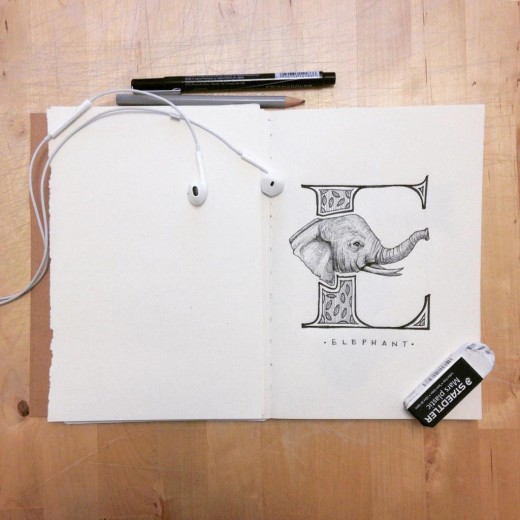
Source: E for Elephant
It was a hand-lettering project, illustrating animals in alphabets. After a several months of commitment, I finally finished all 26 letters. On top of that, I practiced some basic HTML and CSS skills to create a page to showcase the work.
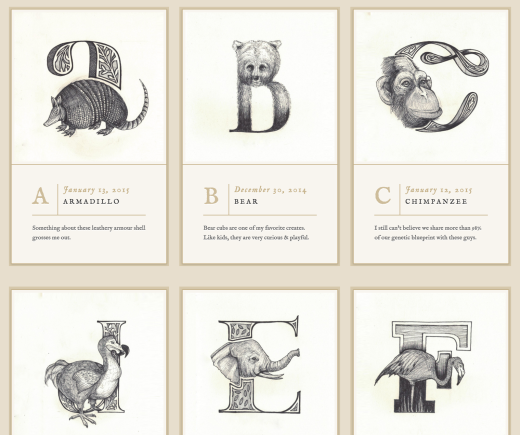
Source: Letters & Animals
Starting a side project isn’t just a way to kill time. It is a powerful way to explore your passion, experiment different ideas, pick up new skills and develop your own aesthetic style as a stronger designer.
While drawing letters differs from sketching product ideas and UX workflows, the techniques certainly transfer over. You learn to visualize in layers, carve shapes from blank spaces and add in the details methodically. When you return to UX sketching, you might find that your wireframes are cleaner and easier to explain to stakeholders.
Of course, your side project could be anything. Just find something you are interested in doing and commit. You could:
- Open up an online store on Etsy with your design goodies
- Write and design a children’s book
- Contribute to an open-source project
- Volunteer your design skills to a non-profit
- Create your own typeface, then sell it on CreativeMarket
3. Immerse yourself with more design books
While working on those animal letters on the side, I was introduced to an opportunity at the Sequoia Creative Lab. I applied as a visiting designer and got the gig.
Deep down, I knew it was my side project that landed me this amazing opportunity to work with Head of Content and Design, James Buckhouse.
On the first day as a visiting designer, I noticed the lab was filled with design books. James excitedly shared with me the different types of books he had, from Sagmeister to Mendelsund to Bringhurst. After working with him for a month and seeing some of his own works, I was simply fascinated with his skills and creative mind. James immerses himself in all things art and design, especially in books. He was always reading.
This week’s books pic.twitter.com/LMyaDQht4G
— James Buckhouse (@buckhouse) January 6, 2015
Inspired myself, I decided to spoil myself with some books this year. The three that I added to my library this year were:
- The World of Ornament by David Batterham
- Less and More: The Design Ethos of Dieter Rams by Klaus Klemp
- Oriental Flowers: Chinese Brush Paintings by Sufan Cai
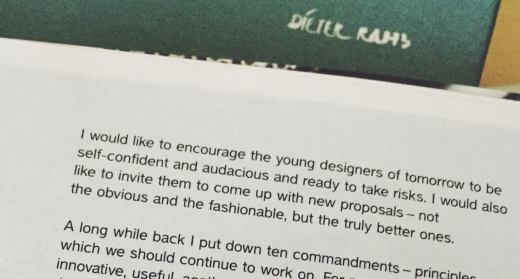
Source: Less and More: The Design Ethos of Dieter Rams
Since traveling is one of my greatest passions, I’m fascinated with the different motifs and patterns from all around the world. I also admire the works and principles of German Designer, Dieter Ram, who inspired many of the Apple design principles.
Lastly, I’m simply in awe with Chinese Painting; there is just something about it that is so simple and free flowing, yet so complex. It reminds me of how user experience should be – simple and easy but actually very complex to build.
These books may seem completely random, but all were very inspiring. It gave me a better understanding about other designs from various cultures around the world and other designers, their design principles, processes and methods.
We’ve all heard the phrase, “You are what you eat.” If you want to become a better designer, simply, consume more design books. Be inspired and enlightened. Learn from people, learn from their mistakes, learn from other cultures.
For product designers, here are a few of my favorite paperbacks you could check out:
- The Design of Everyday Things by Don Norman
- Don’t Make Me Think by Steve Krug
- Hooked: How to Build Habit-Forming Products by Nir Eyal
- Change by Design by Tim Brown
And a few free, comprehensive e-books worth reading:
- Web Design Trends 2015 & 2016
- UX Design Trends 2015 & 2016
- Interaction Design Best Practices (Vol.1)
4. Write and reflect more on your design learnings
Even though I started to pick up a few freelance gigs like the Sequoia Creative Lab stint, I was getting discouraged.
I was stressed and insecure about not having a stable nine to five job. After months of interviewing with different companies, all I received were “you’re not a fit at the moment” messages. I started to doubt whether or not I was even good enough to be a designer.
I spent some time alone with my thoughts and reflected about what I did wrong and where I could improve. A few reoccurring themes kept coming up in my mind.
The Evernote came out and I started writing about lessons learned while being unemployed. After I finishing, I paired each lessons with illustrations and turned it into a microsite. I titled it Six Lessons from an Unemployed Designer and posted it on Designer News.
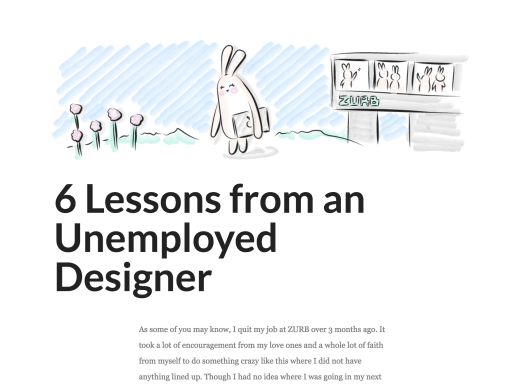
Source: Six Lessons From an Unemployed Designer
That week, emails and tweets poured in. Designers from around the world appreciated these humbling lessons and several were able to relate to them. Who knew writing about failures and feelings of discouragement ended up being a blessing?
Writing helps you become a better designer because you pause on doing. You reflect on your experiences and you learn from them. Not only that, you help other designers empathize, learn, and be inspired from your experiences.
From a practical standpoint, writing also helps you appreciate the power of content as a design element. As you write, you are essentially designing a story with text. When you return to your day job as a UI or UX designer, you’re better able to design an interface to express that type of narrative.
You could write just about anything such as:
- Your humbling experiences as a designer
- Your design case studies for your portfolio
- Your design failures and assumptions on Medium
- Your design process and best practices for publications by Smashing Magazine, UX Magazine and others
5. Spend more time with your design family
Little did I know, my “Six Lessons From an Unemployed Designer” article would continue opening more doors for me.
In May, the founder of a design accelerator, Whitespace, reached out to me after coming across those 6 lessons. We introduced each other, I talked about what I was looking to do next, and he talked about Whitespace.
What got me excited about the program was that sense of design community and culture that I left behind at ZURB. I missed talking about rem vs. em vs. px, mobile-first vs. graceful degradation, hideous type crimes, different design tools and more. I missed sharing various resources and participating in design critiques with a group of creative minds.
So after much thought, I joined the 12-week program. Whitespace had paired me up with Zugata, an employee-centric, data-driven startup that is reimagining the whole performance review process.

The Zugata team sprinting out of stealth
Three days a week, I worked from the Zugata office and the other two days, I spent time with other Whitespace designers. Together, we did many rigorous group critiques and collaborative workshops tied to the projects at our paired startup.
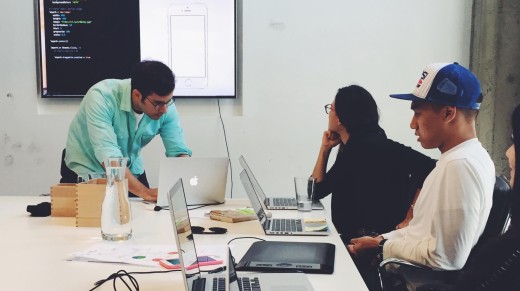
Xoogler Noah Levin teaches framer.js at Whitespace
The instructional team and the designers became the design community and the design support group I was searching for in my career path. At the end of the program, I had gained more experience and gained a spanking brand new design family.
And on top of that, I became a full-time employee Zugata as the founding designer.
Despite all the work required of the lone designer at an early stage startup, I still find the time to attend any Whitespace events and meetups. They are my design family. They inspire me, ground me, and help mentor my decisions.

Source: Whitespace
Branch out, build relationships, spend time with other designers. Let them become your support group. They will inspire and support you to become a better designer.
If you haven’t found your design family quite yet, you could possibly:
- Go to meetups from Dribbble or General Assembly
- Join a design program like Whitespace or Bridge
- Join an online design group like Designers Guild or Spec
- Join an organization like Girl Develop it or UX Book Club
Conclusion
Aristotle once said, “We are what we repeatedly do. Excellence, then, is not an act, but a habit.” So the more you immerse yourself in all things design (teach it, read it, write it), the more you will learn, the more inspired and empowered you will be, and thus the better designer you will be.
Pick one from this list, commit to it, make it a habit. Breathe, eat, sleep design, then lather, rinse and repeat.
Which one will you choose for your 2016 New Year’s resolution?
Read next: 10 Web design trends you can expect to see in 2016
Image credit: Unsplash
Get the TNW newsletter
Get the most important tech news in your inbox each week.





